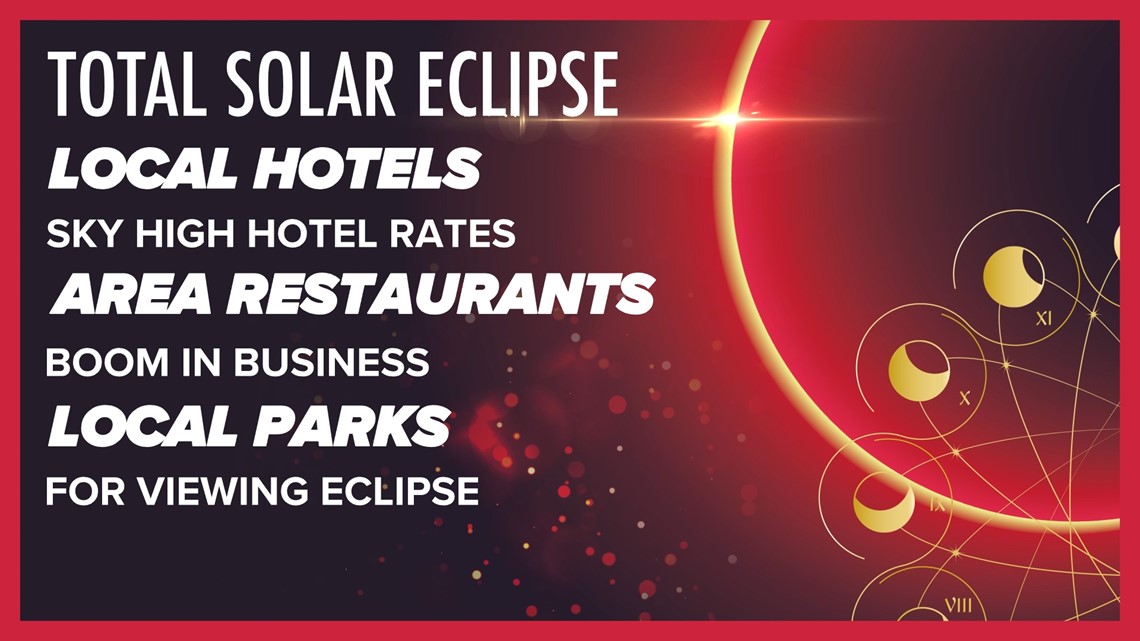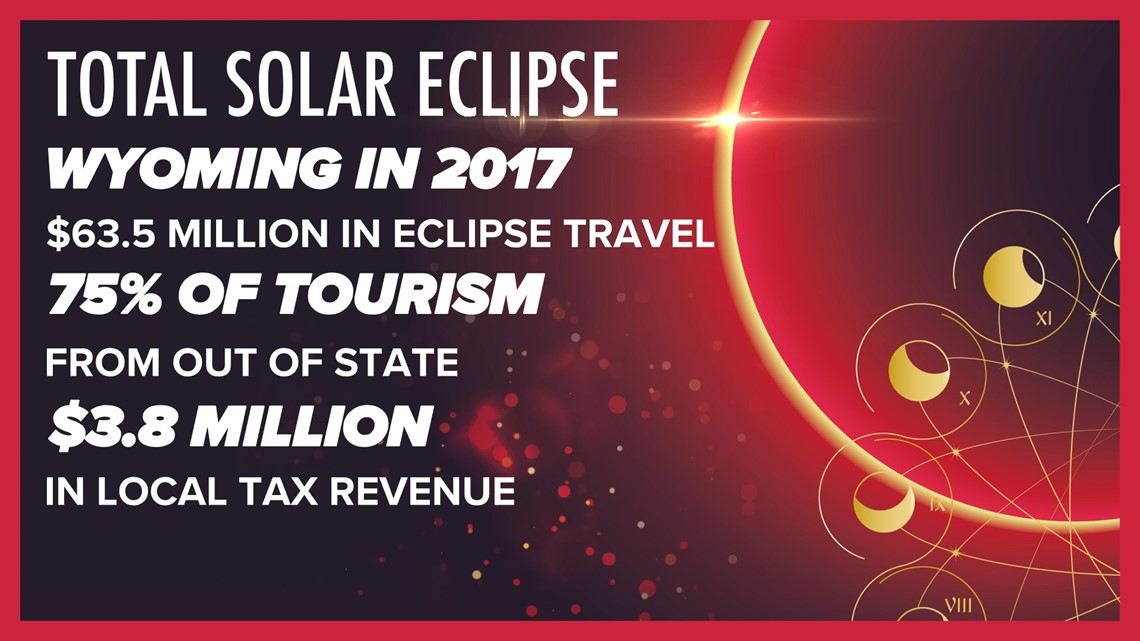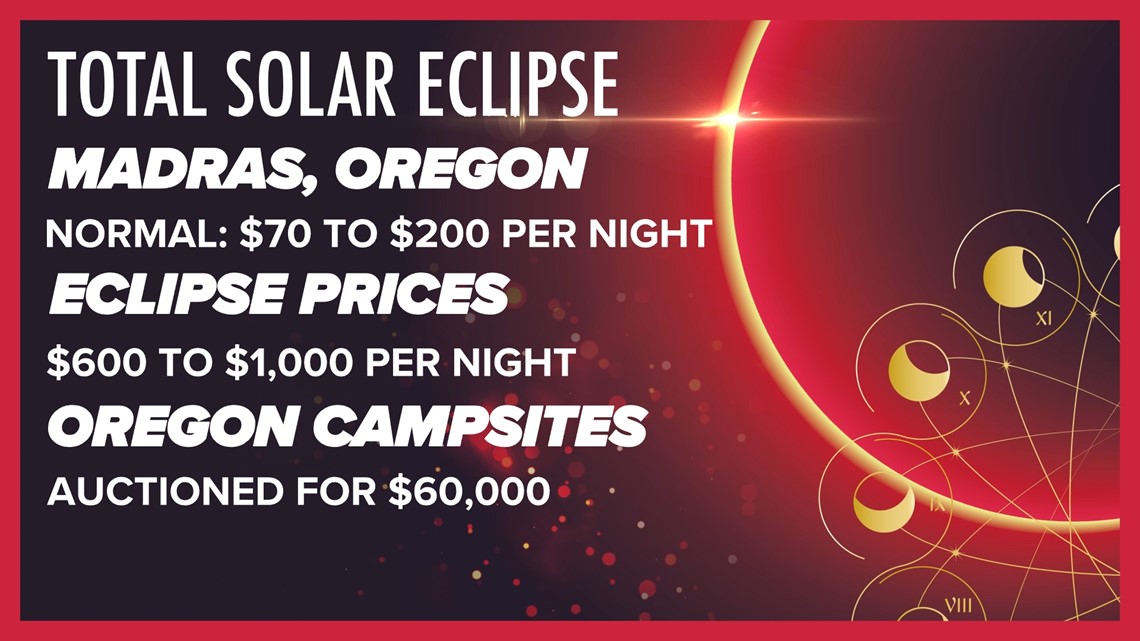TOLEDO, Ohio — With the total solar eclipse just around the corner, the WTOL 11 Weather Team is here to prepare you for the impacts this celestial sighting will bring to northwest Ohio and southeast Michigan.
On April 8, millions of tourists will traverse the country for the rare opportunity to watch the eclipse. Hundreds of thousands will flock to Ohio to observe this once-in-a-lifetime opportunity. How will eclipse tourism impact our area and what financial benefits will it deliver? Meteorologist John Burchfield breaks down the financial impacts of the total solar eclipse.
Northwest Ohio will fall in the sweet spot for eclipse viewing, with the path of totality cutting directly through the region.


Even though tourists will flock to big Ohio cities like Columbus, Cleveland and Toledo, small towns will benefit most. Some northwest Ohio towns, including Forest (population 1,350) and Bloomville (population 867) will see an influx of visitors likely outnumbering the permanent residents.


During the last total solar eclipse, also known as the "Great American Eclipse" of 2017, small towns reaped huge financial benefits. Hopkinsville, Kentucky, a city with a population a little over 30,000, hosted tourists from 46 states and 19 nations.
Branding itself as "Eclipseville," this small Kentucky city saw an unprecedented tourism rush of over 100,000 visitors from around the world. Even though the eclipse only lasted for two minutes and forty seconds, the economic benefits still live on today.
To prepare for the rush of eclipse tourists, the city invested over $500,000 in renovations to spruce up its streets, landscaping, and accommodations. The city started planning for the total solar eclipse a decade in advance, hiring an eclipse coordinator to work with the mayor and allocating funds to optimize the viewing experience for out of town visitors.


Tourists quickly filled up the town, which only has 6 hotels with a total of 600 rooms. Low supply and high demand resulted in a massive spike in hotel prices, a phenomenon that will likely occur in Ohio in 2024.
A price hike in overnight accommodations occurred across the country during the 2017 eclipse. In Casper, Wyoming, for example, hotel rooms normally range from $65 to $195 per night. The nights surrounding the total solar eclipse, nightly hotel rates spiked from $900 to $1,300. This tenfold price surge resulted from high tourist demand and a finite supply of rooms.


Casper, along with much of the state of Wyoming, experienced once-in-a-generation tourism numbers. Visitors to Wyoming spent over $63.5 million in travel experiences during the eclipse, generating $3.8 million in local tax revenue.
Tourism revenue reached sky high during the 2017 "Great American Eclipse" in other western states as well. Oregon experienced a massive influx in tourists, quickly filling up hotel rooms. In an effort to provide more lodging options for tourists, the state auctioned off 30 campsites for visitors with tents or RVs. These prized campsites achieved astronomical prices around $60,000 each.
For those who wanted to sleep indoors during the 2017 eclipse, hotel rooms were hard to come by as well. Nightly hotel rates in the small town of Madras, Oregon climbed from $70 to $200 per night to a whopping $600 to $1,000.


Madras, with a population a little over 7,000, is similar in size to Ohio cities like Port Clinton (population 5,978) and Upper Sandusky (population 6,619). These local towns could see big jumps in hotel prices due to cross-country tourism.
Other northwest Ohio cities like Sandusky, Norwalk, and Tiffin will be hotspot destinations due to their long duration of totality. In these cities, the total solar eclipse will last for close to four minutes, double the duration of the Toledo metro. Hotels in these relatively small cities may spike to several hundred dollars to over $1,000 per night the week of the eclipse.
Many hotels have already told WTOL 11 their rooms are booked. Prepare for vastly increased rates in you plan on travelling to see the eclipse. Low supply and high demand will result in significant spikes in hotel prices across Ohio during the total solar eclipse.
Local businesspeople will enjoy this revenue, while hotel, restaurant and store owners will witness an influx of customers like never before. Due to its prime position in the path of totality, northwest Ohio will reap these financial benefits in both the private sector and government agencies, which will benefit from increased tax revenue.
Statewide, the financial gains from eclipse tourism will benefit the entire Buckeye State. With a path of totality including many metropolitan areas in Ohio, including Toledo, Lima, Columbus, Mansfield, Cleveland, and Akron, much of the state will fall in the sweet spot for eclipse viewing. Rarely does an entire state enjoy such prime viewing during an eclipse, and this excellent location will financially benefit countless communities in Ohio.
For comparison, let's examine the financial impacts to South Carolina during the 2017 eclipse. Most of the state fell in the path of totality, much like Ohio will in 2024. Over 1.6 million tourists flocked to South Carolina to witness the celestial spectacle, including 800,000 from out of state. Ohio will likely also experience roughly 50% of its tourism from out-of-state visitors.


These tourists will spend money at hotels, restaurants and stores. In 2017, tourists to South Carolina funneled over $269 million into the state economy, a figure similar to how much Ohio may make off the 2024 total solar eclipse. While the entire state will benefit financially, local towns and small businesses will benefit most, enjoying revenue that will last for years after the eclipse.
With the total solar eclipse just around the corner, tourists are already planning their travels for viewing. This means booking hotel rooms, searching for local restaurants, and scouting out area parks. These local venues in northwest Ohio will benefit financially from the influx of tourists, seeing revenue like never before.
Time will tell how the exact numbers pan out, but tremendous benefits are expected for our local economy. Stay tuned to the WTOL 11 Weather Team for updates on the impacts the 2024 total solar eclipse will bring to you.

